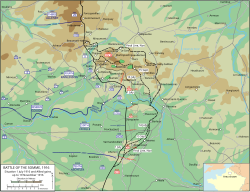
Back معركة بازنتين ريدج Arabic Batalla de Bazentin Spanish Bataille de la crête de Bazentin French Pertempuran Bazentin Ridge ID Battaglia del crinale di Bazentin Italian Trận đồi Bazentin Vietnamese
| Battle of Bazentin Ridge | |||||||
|---|---|---|---|---|---|---|---|
| Part of the Battle of the Somme of the First World War | |||||||
 Map of the Battle of the Somme, 1916 | |||||||
| |||||||
| Belligerents | |||||||
|
| |||||||
| Commanders and leaders | |||||||
| Henry Rawlinson | Fritz von Below | ||||||
| Strength | |||||||
| 5 divisions | 3 divisions | ||||||
| Casualties and losses | |||||||
| 9,194 |
2,300 and 1,400 prisoners (see Casualties section) | ||||||
The Battle of Bazentin Ridge (14–17 July 1916) was part of the Battle of the Somme (1 July – 18 November) on the Western Front in France, during the First World War. On 14 July, the British Fourth Army (General Henry Rawlinson) made a dawn attack against the German 2nd Army (General Fritz von Below) in the Brown Position (Braune Stellung), from Delville Wood westwards to Bazentin le Petit Wood.
Dismissed beforehand by a French commander as "an attack organized for amateurs by amateurs", the British succeeded. Attempts to use the opportunity to capture High Wood failed, due to the German success in holding on to the north end of Longueval and parts of Delville Wood, from which attacks on High Wood could be engaged from the flank. The British cavalry, intended to provide a faster-moving exploitation force, was badly delayed by the devastated ground, shell-holes and derelict trenches.
In the afternoon, infantry of the British 7th Division attacked High Wood, when an earlier advance could have occupied the wood unopposed. The British found German troops in parts of the wood and in the Switch Line along the ridge, which cut through the north-east part of the wood. British cavalry eventually attacked east of the wood and overran German infantry hiding in standing crops, inflicting about 100 casualties for a loss of eight troopers.
The cavalry attack was supported by an artillery-observation aircraft, whose crew saw the Germans in the crops and fired at them with their Lewis guns. The British struggled to exploit the success and the 2nd Army recovered, leading to another period of attritional line straightening attacks and German counter-attacks before the British and French could resume general attacks in mid-September.
© MMXXIII Rich X Search. We shall prevail. All rights reserved. Rich X Search
